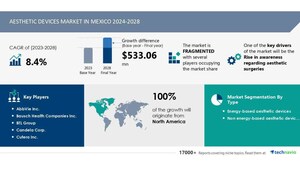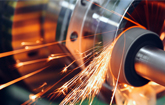NEW YORK, Oct. 1, 2024 /PRNewswire/ -- Report on how AI is redefining market landscape- The global forging market size is estimated to grow by USD 40.4 billion from 2024-2028, according to Technavio. The market is estimated to grow at a CAGR of 6.61% during the forecast period. Advantages of forging over other fabrication techniques is driving market growth, with a trend towards developments in robotics to enhance forging operations. However, instability in variable costs poses a challenge. Key market players include Aichi Steel Corp., Ajax Tocco Magnethermic Corp., Alicon Castalloy Ltd., All Metals and Forge Group, Allegheny Technologies Inc., Aluminum Precision Products, American Axle and Manufacturing Holdings Inc., Asahi Forge Corp., Bharat Forge Ltd., Bruck GmbH, Consolidated Industries Inc., Farinia SA, Fountaintown Forge Inc., Larsen and Toubro Ltd., Mitsubishi Steel Mfg. Co. Ltd., Pacific Forge Inc., Patriot Forge Co., Scot Forge Co., Sumitomo Heavy Industries Ltd., and thyssenkrupp AG.
AI-Powered Market Evolution Insights. Our comprehensive market report ready with the latest trends, growth opportunities, and strategic analysis- View your snapshot now
Forecast period |
2024-2028 |
Base Year |
2023 |
Historic Data |
2018 - 2022 |
Segment Covered |
End-user (Closed die forging, Open die forging, and Seamless rings), Product (Automotive and Others), and Geography (APAC, Europe, North America, South America, and Middle East and Africa) |
Region Covered |
APAC, Europe, North America, South America, and Middle East and Africa |
Key companies profiled |
Aichi Steel Corp., Ajax Tocco Magnethermic Corp., Alicon Castalloy Ltd., All Metals and Forge Group, Allegheny Technologies Inc., Aluminum Precision Products, American Axle and Manufacturing Holdings Inc., Asahi Forge Corp., Bharat Forge Ltd., Bruck GmbH, Consolidated Industries Inc., Farinia SA, Fountaintown Forge Inc., Larsen and Toubro Ltd., Mitsubishi Steel Mfg. Co. Ltd., Pacific Forge Inc., Patriot Forge Co., Scot Forge Co., Sumitomo Heavy Industries Ltd., and thyssenkrupp AG |
Key Market Trends Fueling Growth
In the modern forging industry, automation through robotic technology plays a significant role in enhancing productivity and flexibility. Robots, equipped with sensors for collision resistance, prevent contact with other machines, increasing throughput and reducing machine damage. Robots' extended range of motion, achieved through servo controls and digital servo drives, enables high-speed, high-volume production. Additionally, software innovations allow robots to pick and place parts at any axis, enhancing production line flexibility. Companies like ABB and Rethink Robotics have integrated these advancements into their robots, providing forging manufacturers with efficient and adaptable solutions.
The forging market is experiencing significant growth in various industries such as construction, mining, and material handling. Open die forging is in high demand for producing heavy equipment components like automotive parts, hardware apparatuses, and mechanical equipment. Nickel-based alloys and forged steel are popular choices for aerospace and railway components due to their strength and resistance to extreme temperatures. Lightweight forged steel and aluminum castings are gaining traction in the electric vehicle sector for manufacturing EV components. The metal forming process, including hammering, rolling, and pressing, is essential in creating metal structures for various applications. Nickel-based alloys and stainless steel are preferred for their material strength in extreme temperatures, while forged parts are crucial in passenger vehicles, commercial vehicles, commercial aircraft production, and more. Cracks and empty spaces are major concerns in forging, and manufacturers focus on improving metal composition and production processes to minimize these issues. Overall, the forging market is thriving in diverse industries, with a focus on innovation and efficiency.
Insights on how AI is driving innovation, efficiency, and market growth- Request Sample!
Market Challenges
- The forging industry relies heavily on the availability and affordability of raw materials, such as steel, iron, and alloys, for production. However, the increasing cost of skilled labor, particularly in developed economies, poses a significant challenge to vendors. For instance, while German manufacturing wages rose by over 10% from 2010 to 2020, China's manufacturing wages experienced a remarkable increase of over 95% during the same period. This trend compels vendors to seek low-cost labor markets to maintain profitability. Moreover, the forging industry is susceptible to price fluctuations in raw materials due to scarcity and inflationary pressures. These price changes impact vendors' revenue significantly and introduce uncertainty in their profitability. To remain competitive, vendors must effectively manage raw material costs and adapt to market conditions. In summary, the forging industry's growth is influenced by the availability and cost of raw materials and labor, with vendors constantly navigating these challenges to maintain profitability and competitiveness.
- The metal forming process, which includes hammering, rolling, and pressing, faces various challenges in creating forged metal components. Compressive forces applied during these processes can affect the metal structure and mechanical properties, especially when dealing with different metal compositions like stainless steel, titanium, aluminum, magnesium, and carbon steel. Cold temperatures can make metal parts brittle, leading to cracks and empty spaces. Conversely, high temperatures during forging can impact material strength and increase the risk of fatigue. Manufacturers must consider the climate change implications, aiming for sustainable forged metal production through recycling initiatives. In the aviation industry, lightweight forged metal components from titanium alloys are crucial for aircraft manufacturing, reducing fuel consumption and carbon emissions. Material selection plays a significant role, with aluminum manufacturing and titanium manufacturing being key areas of focus. Closed die forging is a popular choice due to its ability to create complex shapes, while the casting process is suitable for large, simple parts. The steel industry must address these challenges to meet the demands of various sectors, including automotive, aerospace, and construction. By focusing on efficient processes, material selection, and sustainability, forging market players can maintain competitiveness and contribute to a greener future.
Insights into how AI is reshaping industries and driving growth- Download a Sample Report
Segment Overview
This forging market report extensively covers market segmentation by
- End-user
- 1.1 Closed die forging
- 1.2 Open die forging
- 1.3 Seamless rings
- Product
- 2.1 Automotive
- 2.2 Others
- Geography
- 3.1 APAC
- 3.2 Europe
- 3.3 North America
- 3.4 South America
- 3.5 Middle East and Africa
1.1 Closed die forging- Closed die forging involves using an impression die to compress metal, shaping it according to the cavities in the die. The plastic compression process fills the die cavity, resulting in parts with precise dimensions. Acquisitions, such as Scot Forge Co.'s purchase of Grupo Euskal Forging and Farinia SA's acquisition of Steel Industries, are expanding companies' closed die forging capabilities. These strategic moves broaden their product offerings and global reach, fueling the growth of the closed die forging market. Companies focus on controlled material deformation to achieve desired grain structures, ensuring high-quality forged parts.
Download complimentary Sample Report to gain insights into AI's impact on market dynamics, emerging trends, and future opportunities- including forecast (2024-2028) and historic data (2018 - 2022)
Research Analysis
Metal forging is a metal forming process that involves shaping and manipulating raw metal materials under compressive forces. Techniques include hammering, rolling, and pressing. The metal structure and composition determine the suitability for forging, with cold temperatures used for brittle metals like stainless steel and warm or hot temperatures for more ductile metals like aluminum and titanium. Forging creates dense, solid metal parts with improved material strength and eliminates empty spaces. Applications include passenger vehicles, commercial vehicles, commercial aircraft production, and electric vehicle components. Materials include steel, nickel-based alloys, and lightweight forged steel. Forgings can be compared to aluminum castings, each having unique advantages in terms of material properties and manufacturing processes.
Market Research Overview
The forging market encompasses various metal forming processes, including hammering, rolling, and pressing, which apply compressive forces to metal structures to alter their shape and mechanical properties. The composition and temperature of the metal play a significant role in the forging process, with cold temperatures used for brittle metals like stainless steel and warm or hot temperatures for more ductile metals such as aluminum, magnesium, and titanium. Forged metal components are used extensively in various industries, including aerospace and railways, automotive, construction, and manufacturing. Material selection is crucial, with carbon steel, alloy steel, nickel-based alloys, and lightweight forged steel being popular choices. Forging processes like closed die and open die forging are used to create metal parts for aircraft structures, engine components, landing gear, and electric vehicle components, among others. The forging industry is undergoing a shift towards sustainable practices, with recycling initiatives and the use of electric vehicles reducing carbon and CO2 emissions in the steel industry. Forging processes are also used in the production of lightweight metal parts, such as titanium alloys and aluminum castings, which help reduce fuel consumption and improve mechanical properties like fatigue resistance and ductility.
Table of Contents:
1 Executive Summary
2 Market Landscape
3 Market Sizing
4 Historic Market Size
5 Five Forces Analysis
6 Market Segmentation
- End-user
- Closed Die Forging
- Open Die Forging
- Seamless Rings
- Product
- Automotive
- Others
- Geography
- APAC
- Europe
- North America
- South America
- Middle East And Africa
7 Customer Landscape
8 Geographic Landscape
9 Drivers, Challenges, and Trends
10 Company Landscape
11 Company Analysis
12 Appendix
About Technavio
Technavio is a leading global technology research and advisory company. Their research and analysis focuses on emerging market trends and provides actionable insights to help businesses identify market opportunities and develop effective strategies to optimize their market positions.
With over 500 specialized analysts, Technavio's report library consists of more than 17,000 reports and counting, covering 800 technologies, spanning across 50 countries. Their client base consists of enterprises of all sizes, including more than 100 Fortune 500 companies. This growing client base relies on Technavio's comprehensive coverage, extensive research, and actionable market insights to identify opportunities in existing and potential markets and assess their competitive positions within changing market scenarios.
Contacts
Technavio Research
Jesse Maida
Media & Marketing Executive
US: +1 844 364 1100
UK: +44 203 893 3200
Email: [email protected]
Website: www.technavio.com/
SOURCE Technavio

WANT YOUR COMPANY'S NEWS FEATURED ON PRNEWSWIRE.COM?
Newsrooms &
Influencers
Digital Media
Outlets
Journalists
Opted In





Share this article